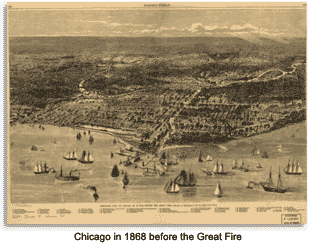Often, in history, the legends are much more entertaining than the facts. Such is the case with the Great Chicago Fire of 1871. The most famous of the colorful legends surrounding this catastrophic event is that the fire was started by a cow's kicking over a lantern, which ignited a barn, spreading the fire to nearby houses and sidewalks and streets, resulting in a large part of the city going up in flames. Actually, only some of that legend is true. Historians do generally agree that one of the flashpoints of the fire was indeed a barn belonging to Patrick and Catherine O'Leary, who lived on DeKoven Street, on the west side of Chicago. The O'Learys did indeed have a cow, but historians highly doubt that the random actions of one animal's foot could unleash such a result. Actually, many historians point to a "perfect storm" of conditions that quite possibly turned a random fire into a raging one.
Here are some facts:
So, by the time the exhausted fire department arrived on the scene, the fire was well and truly out of control. In fact, the Great Fire incinerated 73 miles of streets, houses, and other buildings. Next page > The Aftermath > Page 1, 2 Graphics on ohwy.com, |
|
Social Studies for Kids
copyright 2002–2024
David White


 Many of the houses in Chicago at that time were made of wood and poorly constructed.
Many of the houses in Chicago at that time were made of wood and poorly constructed.

